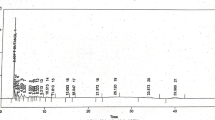Abstract
Essential oils, widely used in society, emit numerous volatile organic compounds (VOCs). Some of these VOCs are considered as potentially hazardous under federal regulations. However, essential oils are exempt from disclosure of their ingredients on their label. Thus, the public may lack information on emissions and potential hazards from essential oils. This study examined VOCs emitted from a range of commercial essential oils, including tea tree oils, lavender oils, eucalyptus oils, and other individual oils and mixtures of oils. Using headspace gas chromatography/mass spectrometry (GC/MS), the study analyzed 24 commercial essential oils, including 12 with claims of being “natural” or related terms, such as organic, 100% pure, or plant-based. Results identified 595 VOCs emitted from the 24 essential oils, representing 188 different VOCs. The most common VOCs emitted were alpha-pinene, limonene, acetone, linalool, alpha-phellandrene, beta-myrcene, and camphene. Among the 589 VOCs identified, 124 VOCs, representing 33 different VOCs, are classified as potentially hazardous. All natural and regular essential oils emitted one or more potentially hazardous VOCs, such as acetaldehyde, acetone, and ethanol. Toluene was also found in 50% of essential oils. Moreover, for the prevalent VOCs classified as potentially hazardous, no significant difference was found between regular and natural essential oils. This study provides insights and information about emissions of commercial essential oils that can be useful for public awareness and risk reduction.
Similar content being viewed by others
References
Bagasra O, Golkar Z, Garcia M, Rice LN, Pace DG (2013) Role of perfumes in pathogenesis of autism. Med Hypotheses 80:795–803. https://doi.org/10.1016/j.mehy.2013.03.014
Cheng WH, Lai CH (2014) Sampling gaseous compounds from essential oils evaporation by solid phase microextraction devices. Atmos Environ 99:124–129. https://doi.org/10.1016/j.atmosenv.2014.09.069
Chiang HM, Chiu HH, Lai YM, Chen CY, Chiang HL (2010) Carbonyl species characteristics during the evaporation of essential oils. Atmos Environ 44:2240–2247. https://doi.org/10.1016/j.atmosenv.2010.02.017
Chiu HH, Chiang HM, Lo CC, Chen CY, Chiang HL (2009) Constituents of volatile organic compounds of evaporating essential oil. Atmos Environ 43:5743–5749. https://doi.org/10.1016/j.atmosenv.2009.08.002
Francis GW, Stusdal TK (2014) Differential evaporation of aromatherapy mint oils. Air Qual Atmos Health 7:481–487. https://doi.org/10.1007/s11869-014-0245-z
Globally Harmonised System of Classification and Labelling of Chemicals (GHS) (2018), Safe Work Australia, classifying chemicals: the GHS. https://www.safeworkaustralia.gov.au/classifying-chemicals#the-ghs
González-Rivera J, Duce C, Falconieri D, Ferrari C, Ghezzi L, Piras A, Tine MR (2016) Coaxial microwave assisted hydrodistillation of essential oils from five different herbs (lavender, rosemary, sage, fennel seeds and clove buds): chemical composition and thermal analysis. Innovative Food Sci Emerg Technol 33:308–318. https://doi.org/10.1016/j.ifset.2015.12.011
Helmig D, Daly RW, Milford J, Guenther A (2013) Seasonal trends of biogenic terpene emissions. Chemosphere 93:35–46. https://doi.org/10.1016/j.chemosphere.2013.04.058
Huang HL, Tsai TJ, Hsu NY, Lee CC, Wu PC, Su HJ (2012) Effects of essential oils on the formation of formaldehyde and secondary organic aerosols in an aromatherapy environment. Build Environ 57:120–125. https://doi.org/10.1016/j.buildenv.2012.04.020
Isidorov V, Jdanova M (2002) Volatile organic compounds from leaves litter. Chemosphere 48:975–979
Lee SJ, Umano K, Shibamoto T, Lee KG (2005) Identification of volatile components in basil (Ocimum basilicum L.) and thyme leaves (Thymus vulgaris L.) and their antioxidant properties. Food Chem 91:131–137. https://doi.org/10.1016/j.foodchem.2004.05.056
Lee CJ, Chen LW, Chen LG, Chang TL, Huang CW, Huang MC, Wang CC (2013) Correlations of the components of tea tree oil with its antibacterial effects and skin irritation. J Food Drug Anal 21:169–176. https://doi.org/10.1016/j.jfda.2013.05.007
Nematollahi N, Doronila A, Mornane PJ, Duan A, Kolev SD, Steinemann A (2018) Volatile chemical emissions from fragranced baby products. Air Qual Atmos Health:1–6. https://doi.org/10.1007/s11869-018-0593-1
SafeWork Australia (SWA) (2018) Hazardous chemical information system (HCIS): search hazardous chemicals, http://hcis.safeworkaustralia.gov.au/HazardousChemical
Sarkic A, Stappen I (2018) Essential oils and their single compounds in cosmetics — a critical review 1–21. https://doi.org/10.3390/cosmetics5010011
Stein SE (2008) NIST Standard Reference Database 1A. In: The National Institute of Standards and Technology NIST. pp 1–49
Su HJ, Chao CJ, Chang HY, Wu PC (2007) The effects of evaporating essential oils on indoor air quality. Atmos Environ 41:1230–1236. https://doi.org/10.1016/j.atmosenv.2006.09.044
Winters AJ, Adams MA, Bleby TM, Rennenberg H, Steigner D, Steinbrecher R, Kreuzwieser J (2009) Emissions of isoprene, monoterpene and short-chained carbonyl compounds from Eucalyptus spp. in southern Australia. Atmos Environ 43:3035–3043. https://doi.org/10.1016/j.atmosenv.2009.03.026
World Health Organization (WHO) (2018) International Agency for Research on Cancer (IARC): IARC Monographs on the Evaluation of Carcinogenic Risks to Humans, list of classifications, vol 1–120, http://monographs.iarc.fr/ENG/Classification/latest_classif.php
Acknowledgments
The study received support from the Australian Government Research Training Program Scholarship (RTP), through the University of Melbourne; the Australian Department of Education and Training (Australian Postgraduate Award); and the Commonwealth Scientific and Industrial Research Organisation (CSIRO). This article is dedicated to the memory of Neda Yarmahmoudi.
Author information
Authors and Affiliations
Corresponding author
Rights and permissions
About this article
Cite this article
Nematollahi, N., Kolev, S.D. & Steinemann, A. Volatile chemical emissions from essential oils. Air Qual Atmos Health 11, 949–954 (2018). https://doi.org/10.1007/s11869-018-0606-0
Received:
Accepted:
Published:
Issue Date:
DOI: https://doi.org/10.1007/s11869-018-0606-0




